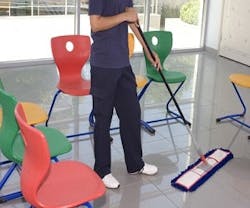School Facility Floor Care
School facility managers and building owners should be looking to score high marks in liability prevention and maintenance. Proper floor care goes far beyond keeping surfaces safe and clean, and includes methods to extend floor life and the proper selection of materials. Staples Advantage offers some tips to help get the most out of your school facility floor care initiatives:
Always clean: Facility managers should make sure they only use solutions that are appropriate for the floor material they are cleaning and to read the manufacturer instructions to be certain they are mixing and applying the solution properly. Remember to look for sustainable cleaning solutions that are not only healthier for students and maintenance staff, but fit into tight school budgets as well.
Other tips to keep in mind: spills on the floor should be wiped up with an absorbent cloth immediately. One of the best methods for protecting floor surfaces is to use floor mats at each entrance that are specially designed to capture moisture and debris that can be tracked inside on shoes.
Be mindful of safety and liability: Slips and falls can cause serious injury. There are several precautions facility managers and custodians can take to reduce liability with regard to flooring. Educate school administrators and teaching and maintenance staff about potential floor hazards and ask them to report spills, floor damage or other safety concerns immediately.
It would be even more beneficial to assign someone on the maintenance staff to be responsible for checking all floor surfaces for potential dangers on a daily basis. Proper lighting in all areas of a school facility is key to prevent slips and falls. Remember – no running in the halls!
Computers can be zapped: Believe it or not, flooring can have a negative impact on school computers and handheld devices that are used for learning. Electrostatic discharges (ESD) – that shock you feel sometimes when you walk across the floor and touch something – can easily be transferred to computer devices from the floor.
Costly damages can be prevented by using conductive flooring material or by applying several coats of an ESD-preventing finish solution to the existing floor of the computer lab, library or classroom. Once the floor protection is applied, special care must be taken with daily and weekly cleaning to ensure the effectiveness of the solution. Another option is the use of special mats, floor paint or tiles that help prevent electrical shocks to computers.
